Philips LatteGo 4400 Series: Two-minute review
The Philips LatteGo 4400 Series is a fully automatic bean-to-cup espresso machine that’s a great option for smaller households or anyone making their first venture into the world of one-touch coffee machines. It’s very similar to the LatteGo 5500 Series that my UK-based colleague, Cat Ellis, has previously reviewed, and just misses out on a few preset drink recipes.
Otherwise, the two machines adopt the exact same dimensions, meaning their bean hopper and water tanks are the same size at 275g and 1.8L respectively, and, as the name implies, the 4400 Series on review here also uses Philips’ LatteGo milk-foaming system. This sees a milk carafe clip onto a steam nozzle on the front of the machine, with the idea being that you fill it with just enough milk for your chosen drink(s) once it’s attached.
Given the two machines make coffee in the exact same way, you’d expect the review of the 4400 Series to read largely the same, then, wouldn’t you? Well, while I do agree with much of Cat’s review of the 5500 Series, and that the Philips espresso machine does produce good-tasting coffee, I picked up on a few niggles during my time using the 4400. These mainly relate to the LatteGo system and the steps required to brew a coffee. I’ll explain more about both in the performance section of this review.
Ultimately, the Philips 4400 LatteGo coffee machine is incredibly simple to use and offers everything you need to make a great coffee, whether it be a simple espresso or ristretto shot, a larger latte, cappuccino or even a few iced drinks.
As with the 5500 Series, the 4400 Series doesn’t offer cold coffee extraction. If you want to make an iced drink, you’ll need to add ice cubes to a glass or mug for the machine to then pour on a hot shot of espresso. This machine can’t make iced lattes, so if you do want a milk-based iced drink, you’ll need to make do with pouring cold milk directly into your glass or mug.
If you like cold coffee, then you may not like the flavor profile delivered by the 4400 Series, and, as Cat found in her review, once the ice melts it can make the coffee taste weaker. Personally, I enjoyed making iced drinks using the Philips 4400 Series, but it’s ultimately a matter of personal preference.
Furthermore, having previously reviewed the De’Longhi Magnifica Evo Next automatic espresso machine, I found myself preferring the taste of the coffee produced by the Philips machine instead, and I appreciated the smaller footprint it took up on my kitchen counter.
However, as a plant milk drinker, I did prefer the level of milk foam produced by the De’Longhi’s LatteCrema system compared to the LatteGo milk-foaming system used by the Philips machine.
Philips LatteGo 4400 Series: Price and availability
- List price $799.99 / £599.99 / AU$1,199
- Available globally
- Often discounted
The Philips LatteGo 4400 Series is available globally with a list price of $799.99 / £599.99 / AU$1,199. At the time of writing, however, I was able to find it discounted to £499.99 in the UK and below AU$1,000 in Australia.
The 4400 Series sits one step down from the flagship 5500 Series, offering 12 hot and cold drink recipes compared to the 20 options found on its higher-spec sibling.
Its list price places it in a similar category to the De’Longhi Magnifica Evo Next fully automatic coffee machine that I’ve previously reviewed.
The two machines are similarly specced, although the De’Longhi unit is much larger. The Philips 4400 Series would therefore be my recommendation if your kitchen is on the smaller side.
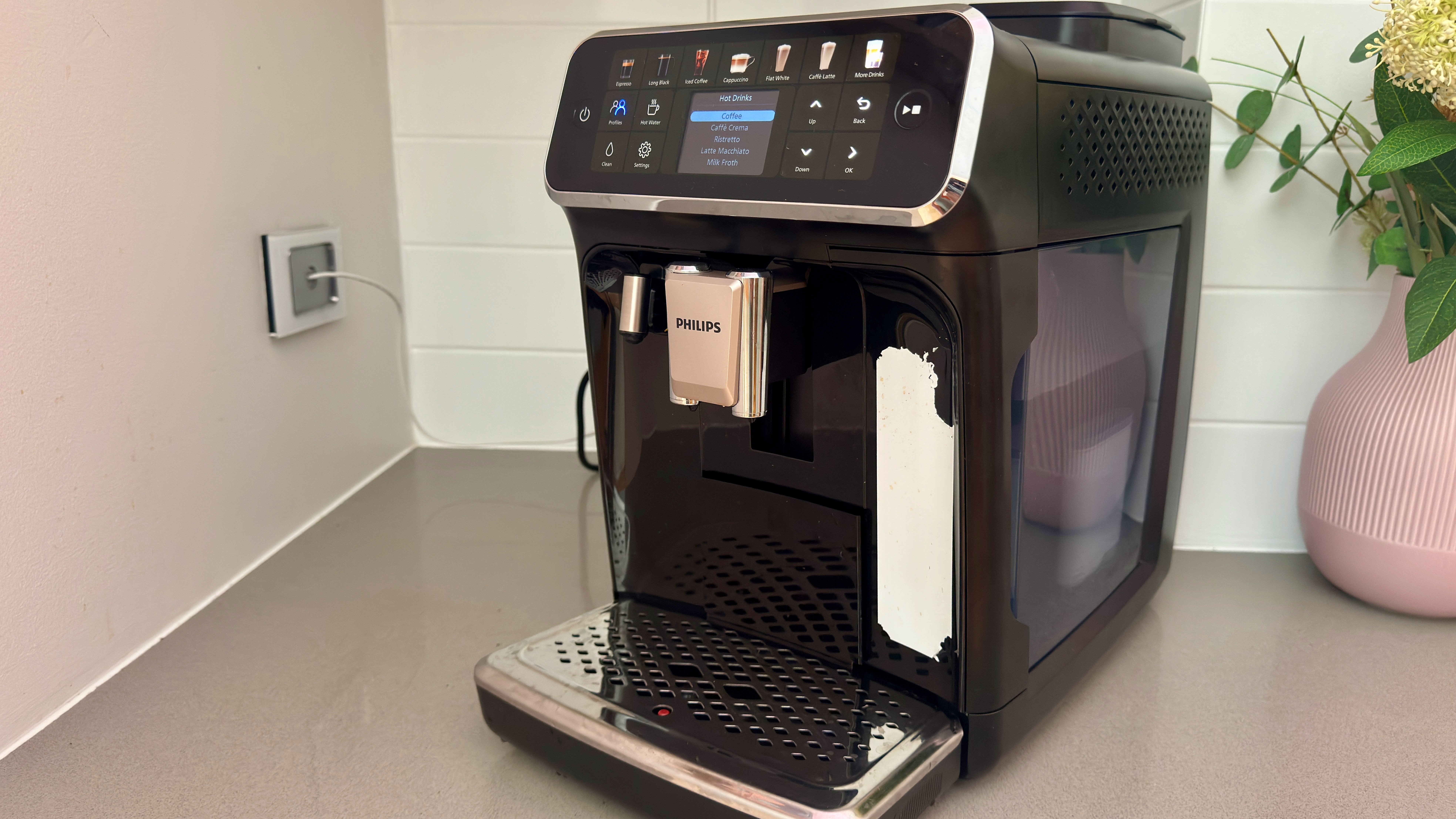
- Value score: 4 / 5
Philips LatteGo 4400 Series: Specs
Swipe to scroll horizontally
Name | Philips LatteGo 4400 Series |
Type | Fully automatic bean-to-cup espresso machine |
Dimensions (W x H x D) | 9.7 x 14.6 x 17in / 24.6 x 37.1 x 43.3cm |
Weight | 17.6lbs / 8kg |
Water reservoir capacity | 1.9qt / 1.8 liters |
Milk frother | Yes (automatic) |
Bars of pressure | 15 |
User profiles | 2 (plus guest) |
Philips LatteGo 4400 Series: Design
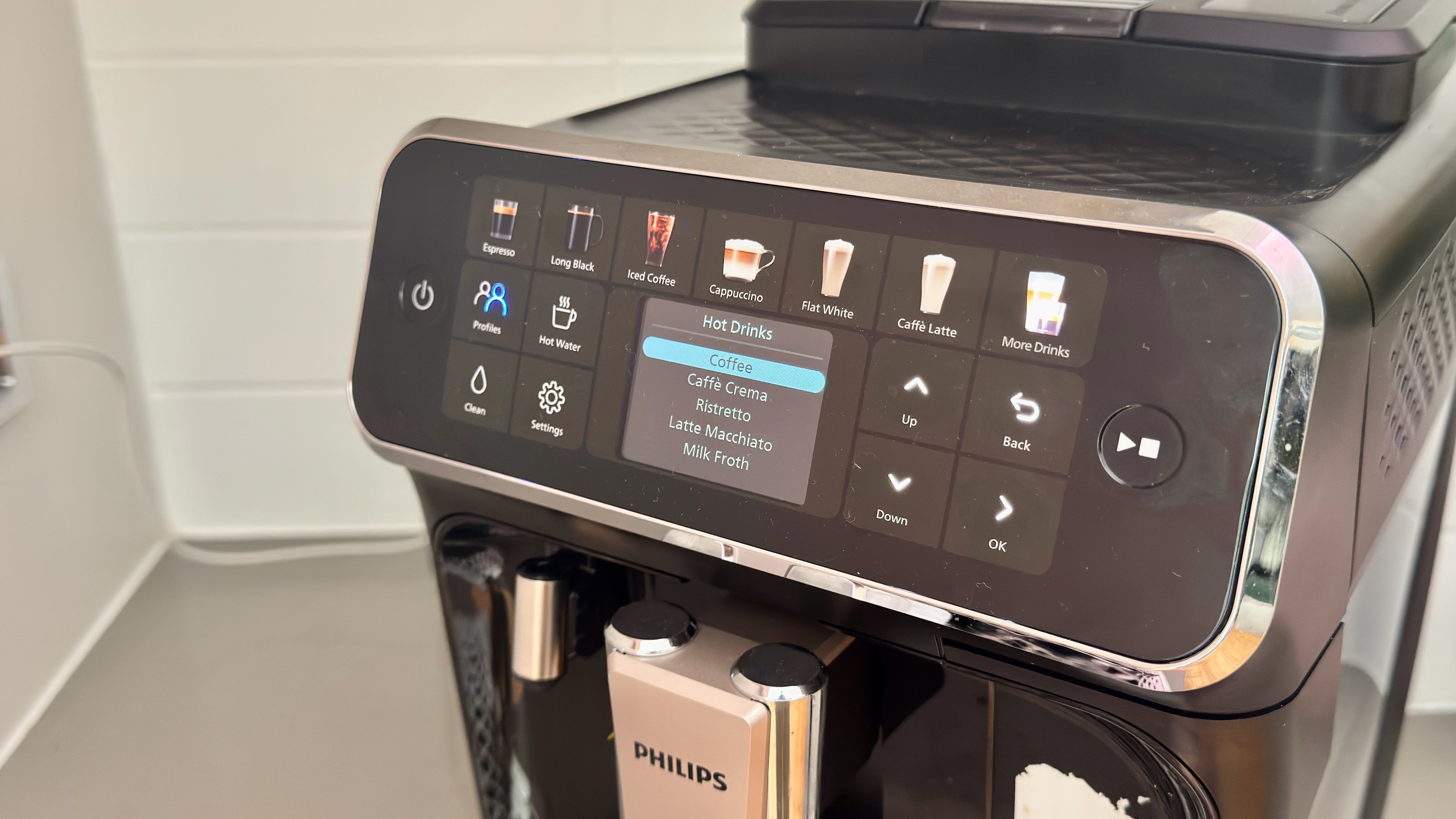
- Compact, ideal for smaller kitchens
- Intuitive, button-based navigation
- Easy to clean and maintain but cleaning agents sold separately
The Philips LatteGo 4400 Series is a relatively compact bean-to-cup espresso machine, coming in at 9.7 inches / 24.6cm wide and 17 inches / 43.3cm long.
As a result, it makes placing it on a kitchen countertop quite easy, as it can be placed in a corner, for example and up against the wall, since the water tank slides out from the front. The brewing group head is accessed via the side behind the water tank, making maintenance just as simple.
The machine is controlled via a series of touch buttons on the front, which flank a 2.3-inch color display. A selection of popular coffee-based drinks have dedicated buttons on the front – including espresso, long black, cappuccino and flat white – while the remaining hot and cold drinks are accessed via a ‘More Drinks’ button.
You’ll also find a ‘Profile’ button on the front, which is used to cycle through two main profiles – Yellow and Blue – and a third guest profile to ensure your saved presets aren’t overridden.
The non-removable bean hopper is accessed at the top. All you need to do is remove the tinted plastic lid – by being tinted, it helps to prevent light from degrading the flavor of the beans – which is also airtight to maintain freshness. If you want to adjust grind settings, that’s done via a control dial set inside the bean hopper.
It’s not particularly large with a capacity up to 275g of beans, but this makes it a good option for single-person or couple households. Plus, the fact it’s airtight means you can leave beans in between uses and not worry about them spoiling, as opposed to pouring in just the right amount of beans for the drink you want to make.
As is the case with the De’Longhi Magnifica Evo Next I’ve previously reviewed, Philips says to only operate the grind adjustment whilst beans are being ground. It took me a little while to figure out how to actually use the dial, and after consulting the user manual, I realized you have to first press down on it before rotating.
There are 12 grind settings to choose from, with the halfway point setting 6 being the default. Philips says this should be ideal for most users, and recommends not adjusting it until you’ve made 100 to 150 drinks. I found during my review period that I did have to adjust to a finer setting – I settled on 4 – to achieve a thicker crema and a more flavorful coffee.
The Philips 4400’s LatteGo milk-frothing system comprises a small carafe that attaches to a steam nozzle on the front of the machine. It’s designed to be filled with just enough milk for whatever drink you want to make, as opposed to being stored in the fridge with leftover milk between uses. You can still store the milk in the fridge if you wish, but just note the lid isn’t airtight.
I liked the idea of this, but in reality I came across a couple of slight niggles.
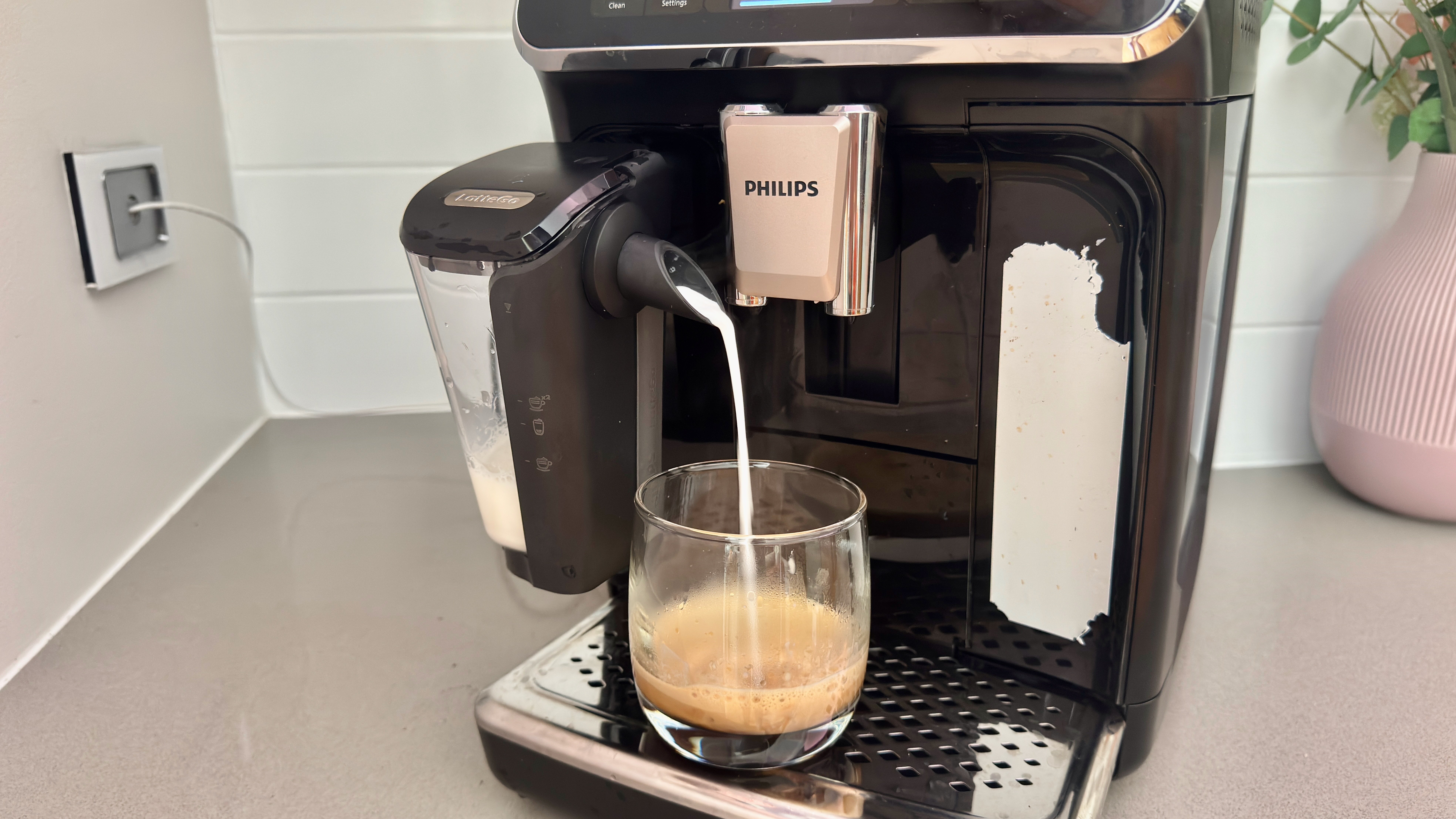
The carafe has markings on the side for a single cappuccino, a single latte macchiato or two cappuccinos. I filled the carafe with oat milk to the line for the single cappuccino and poured one, and found it didn’t use all the milk.
Plus, when you’re selecting a coffee to make, you can adjust the volume of coffee and milk that goes in. If you adjust the volume of milk, for example, then you’ll need to ensure enough is in the carafe, making the markings somewhat redundant.
I’ll speak about it more in the performance section, but I also wasn’t overly happy with the level of (or lack of) milk foam produced by the system. Full-fat dairy milk did fare a lot better than plant milk during my tests though.
The Philips LatteGo 4400 Series does have some other design features that I found useful, including a deep grounds container bin and a decently sized drip tray. The machine will let you know when the ground container needs emptying, but this won’t be that regular since it’s capable of storing a good amount of waste.
Another positive I noticed was how well-packaged the machine was, and that Philips used predominantly recyclable cardboard.
One thing worth noting is that you aren’t supplied with any cleaning tablets or descaling solution. Having reviewed coffee machines from De’Longhi and Australian brand Sunbeam, both of which do supply some cleaning products with their machines, I had expected the same from Philips.
Cleaning tablets can be bought online from stores such as Amazon, but it’s an extra cost you’ll need to consider. While the AquaClean filter should last some time – it will cease working once 95 liters (around 625 coffees) of water has flowed through it – it will also be an additional expense to replace.
As long as you keep replacing the filters on time, then you won’t need to descale the machines for 5000 coffees – 8 filters worth. At $20 / £12 / AU$29 per filter, that’s about $160 / £96 / AU$232 to delay the need to descale, but slightly less if buying in bulk.
In comparison (depending on your water hardness), without the filters, you would typically need to descale up to about 10 times for 5000 cups, with the total cost around half of buying new filters.
Finally, another thing I noticed was when removing a sticker on the front of the machine referencing the fact it can make 12 different coffee-based drinks, it left some adhesive behind (the white part to the right of the coffee spout in the pictures).
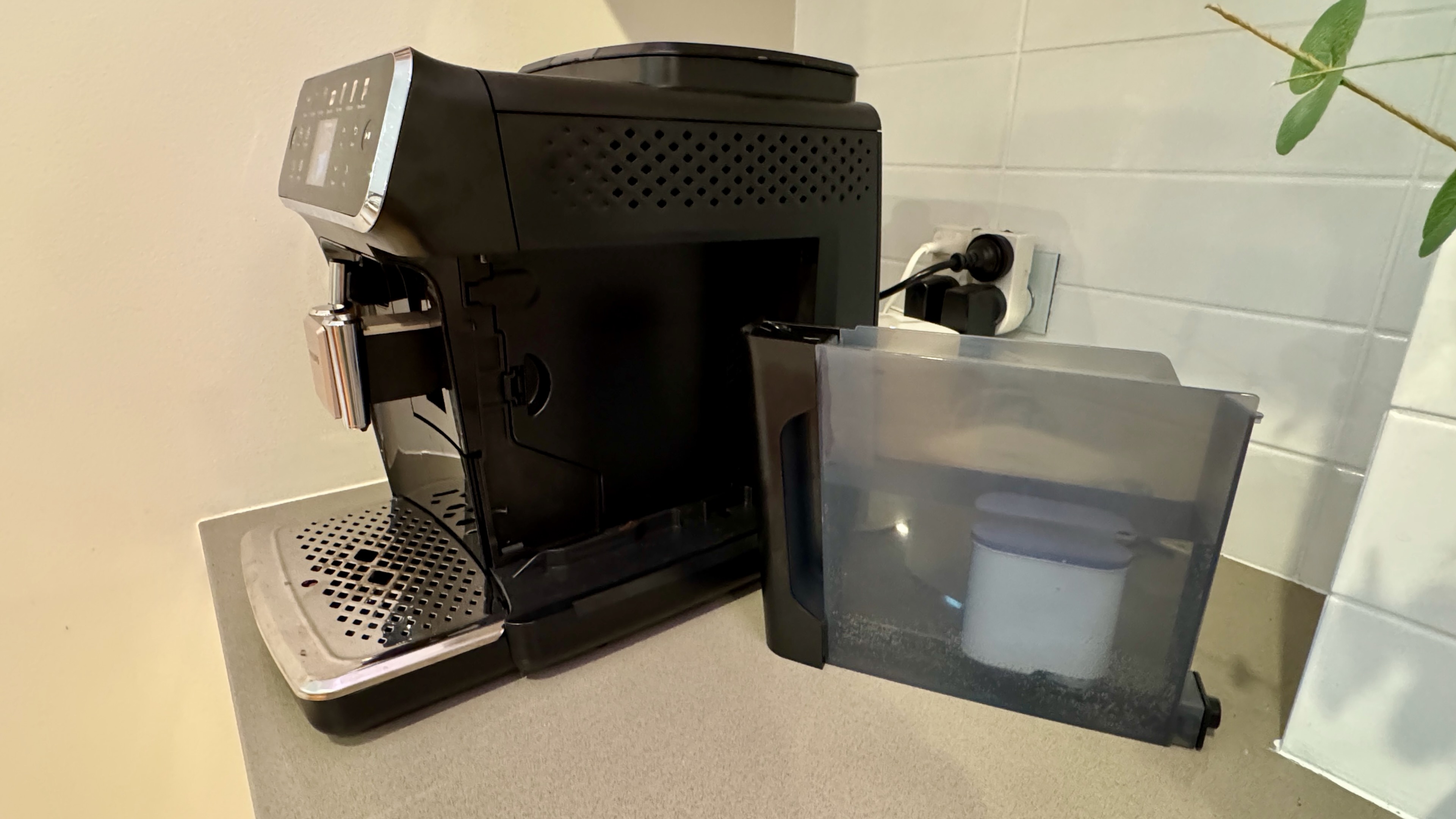
- Design score: 4.5 / 5
Philips LatteGo 5500 Series review: Performance
- Great-tasting coffee with some grinder adjustment
- Good level of personalization
- LatteGo milk-foaming system not without fault
The Philips LatteGo 4400 Series is an incredibly easy espresso machine to use. Once you’ve got it set up – this involves testing your water for hardness and installing the supplied AquaClean filter if required – you’ll be brewing a coffee in seconds. The central color display provides information clearly, and buttons are logically laid out to navigate through menus and drinks to adjust settings.
There are 12 drinks to choose from:
- Espresso
- Coffee
- Long black
- Cappuccino
- Latte macchiato
- Caffè crema
- Caffè latte
- Ristretto
- Flat white
- Iced espresso
- Iced long black
- Iced coffee
Once you’ve selected a drink to make, a secondary screen allows you to adjust the strength and volume. In some cases, increasing the volume of coffee will mean the machine will have to grind beans twice, which can increase the speed you go through a bag. I increased the volume of my daily flat white from the default 80ml to 100ml, for example, and I had to wait for the machine to grind a second dose of beans before it was finished.
If you tweak the settings for a drink, whether it be strength or volume, the machine will save them for the next time. Each time you make an adjustment, it overrides the previous settings. If two people in the same household want the same drink but with different settings, I would recommend taking advantage of the two individual profiles to store personal drink preferences. Switching between profiles is simple thanks to a dedicated button on the front panel.
If there are more than two people in your home and each has their own preference, you’ll be better served by stepping up to the 5500 Series model, which has 4 profiles plus a separate guest profile.
The machine doesn’t provide feedback regarding grind size or whether it’s ideal for the beans you’ve used – something you will find on De’Longhi machines that have BeanAdapt technology such as the Rivelia – but you can manually adjust the grind setting to produce a well-extracted espresso. The default setting of 6 should be fine for most use cases, although I did find for the beans I used, the crema wasn’t as thick as I would like, and it dissipated relatively quickly. As mentioned previously, I was much happier with the result once I adjusted the grinder to setting 4 for a finer grind.
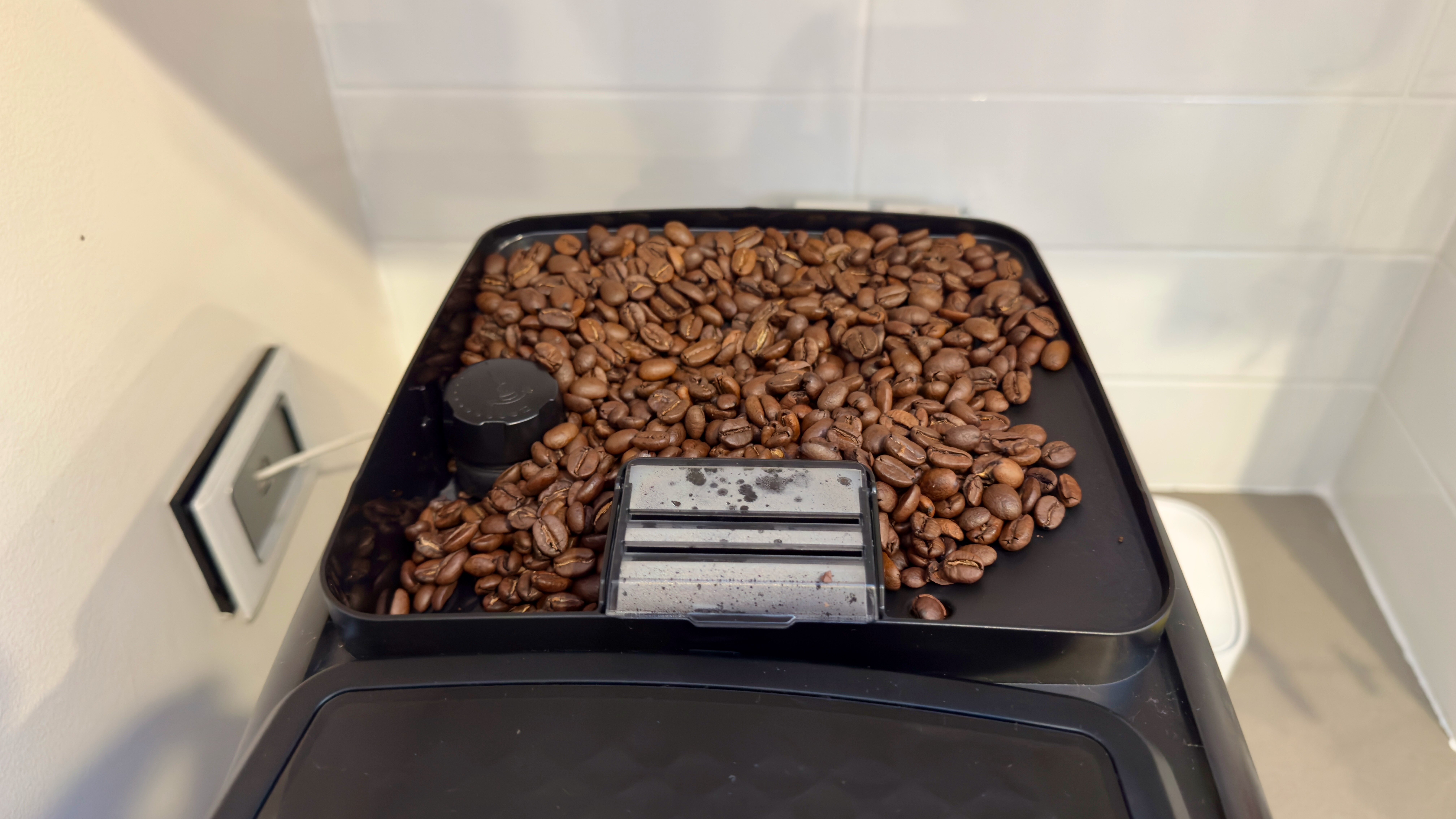
Where I experienced a bit more of an issue was when using the LatteGo milk-foaming system. Having read about it on the Philips website and in my colleague Cat’s review of the more feature-packed 5500 Series model, I was expecting great results from the company’s take on automatic milk frothing. I wasn’t entirely satisfied with the performance, although I think some leniency should be applied.
Firstly, the milk carafe is a little awkward to attach to the steam nozzle. Not frustratingly so, but it requires a more steady hand compared to the approach taken by De’Longhi, whose LatteCrema milk carafe easily inserts into a cutout on the front of its machines.
Secondly, there are markings on the side of the carafe to indicate how much is required for a particular drink. In practice, I found these to be inaccurate, and I always had some leftover milk in the carafe. Because the lid isn’t airtight, I had to pour this away if I knew I wasn’t going to have another coffee soon after the first.
Finally, despite using a barista-level brand of oat milk, which has a higher protein content to assist with producing a thicker foam, the milk pushed out into my coffee mug lacked any real resemblance to proper foam. It was certainly foamier than if I just poured milk from the carton, but when I compared the results to using my Nespresso Aeroccino 3 milk frother, it was a clear win for Nespresso. I also tested the LatteGo system with full-fat dairy milk and it did produce a much thicker foam.
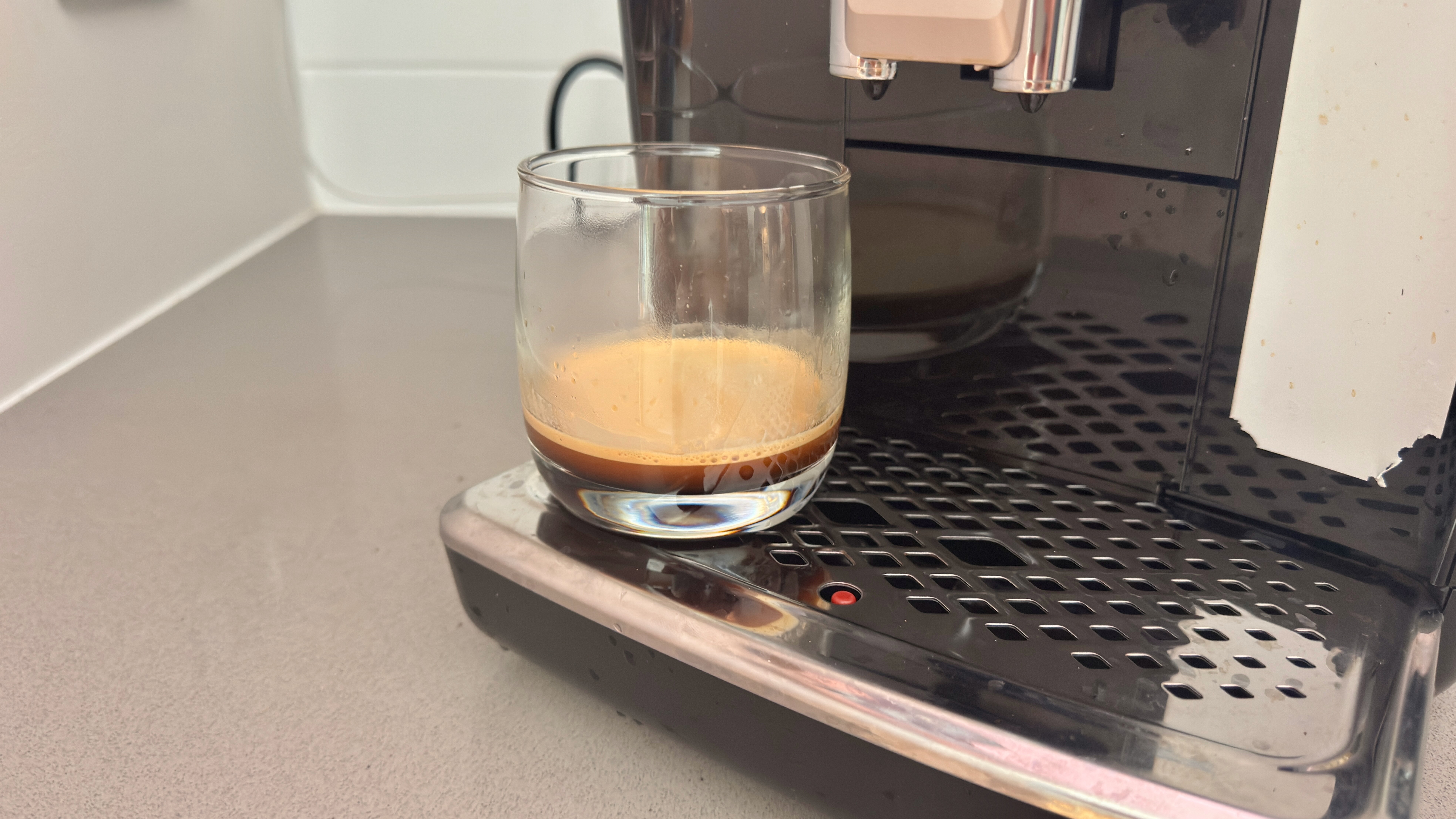
Where I want to give some leniency is the fact that I wasn’t super satisfied with the results of the De’Longhi LatteCrema system when I reviewed the Magnifica Evo Next automatic coffee machine. I’ve yet to try similar systems from the likes of KitchenAid or Smeg, but I do wonder if the way they – creating steam and mixing with milk to aerate it – is that effective on the whole. In my mind, if you enjoy cafe-quality levels of milk foam, then you’ll be better served by an espresso machine with a steam wand.
I also experimented with iced drinks using the 4400 Series, although as Cat discovered in her review of the 5500 Series, the 4400 Series machine doesn’t actually produce cold coffee. Instead, you’re instructed to put ice cubes into a mug or glass, which then cools the coffee down. Philips does say water and coffee produced for iced drinks is “warm” rather than hot, so it will cool down quicker when poured over ice. I didn’t necessarily mind this approach, but it did make me wonder why there are iced drink recipes in the first place. I could just as easily place ice in a mug and run a regular espresso shot, rather than select iced espresso.
The 4400 Series only has three iced drink presets: iced espresso, iced coffee and iced long black. I like an iced latte and so poured cold milk into a glass with ice cubes and ran an iced espresso shot. For my tastes, the result was superb, and my partner enjoyed his iced long black. The 5500 Series does have a preset for iced latte, which pours cold milk via the LatteGo system.
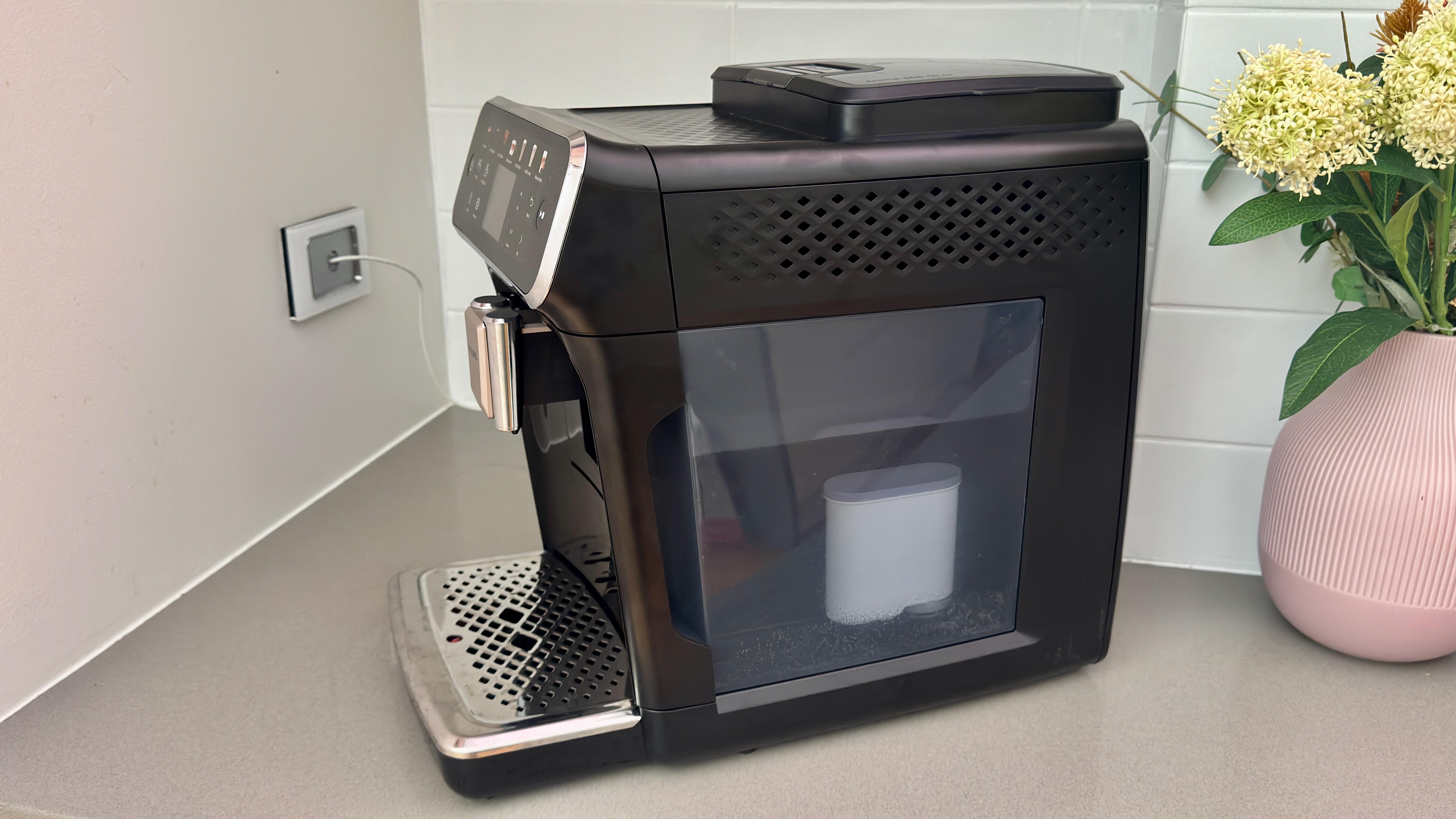
Finally, the Philips 4400 LatteGo uses what the company calls SilentBrew technology to keep noise levels to a minimum. It’s also Quiet Mark certified, meaning it’s among the quietest in its product class. Knowing this, I assumed I’d hear near-silence from the machine during use, but in reality it was louder than I had expected. Using the Decibel X app on my iPhone and standing next to the machine, I recorded a measurement of 69dB when the machine was grinding beans and around 60dB when espresso was being poured. That’s louder than the KitchenAid KF8, which is also Quiet Mark certified. We recorded a measurement of 66dB when grinding and an average volume of just 44dB in our KitchenAid KF8 review.
- Performance score: 4.5 / 5
Should I buy the Philips LatteGo 4400 Series?
Swipe to scroll horizontally
Value | Affordable and often discounted, although other great options can be picked up for less during sales. | 4 / 5 |
Design | Compact size will suit most kitchens, easy to clean and intuitive interface | 4.5 / 5 |
Performance | Great results across all drinks, just don’t set your expectations too high for the LatteGo system | 4 / 5 |
Buy it if...
You have limited kitchen space
The Philips LatteGo 4400 is a compact, narrow machine and only needs side access to remove the water tank and brewing group head. You can push it into a corner no problem.
You’re new to automatic coffee machines
This machine is incredibly easy to master, with clear and intuitive drinks, menus and settings. You’ll be brewing coffee after coffee in no time.
Don't buy it if...
You have a large household
The 4400 Series only has 2 selectable profiles. If you have multiple coffee drinkers with different preferences, you’ll likely end up overriding each other’s settings.
You like cold-brewed coffee
While you can make good iced drinks with the 4400 Series, it doesn’t produce authentic cold-brew coffee. It also can’t make iced lattes.
Philips LatteGo 4400 Series: Also consider
If you're not sure that the Philips LatteGo 5500 Series is the right coffee maker for you, here are two other options for your consideration.
KitchenAid KF6
It’s a little bit more expensive, but the KitchenAid KF6 has the looks to back it up and it produces a superb shot of espresso. Plus, it’s incredibly easy to use.
Read our full KitchenAid KF6 review
Ninja Luxe Cafe
You’ll need more space in your kitchen to accommodate it, but this bean-to-cup machine from Ninja produces fantastic espresso and is packed with features, including grind size suggestion, weight-based dosage system and an automatic milk frother.
Read our full Ninja Luxe Cafe review
How I tested the Philips LatteGo 4400 Series
I tested the Philips LatteGo 4400 Series over a period of two weeks with some coffee beans from a local supermarket that I had used before. I tested the water hardness using the strip supplied in the box and fitted the water tank using the instructions provided.
I tested the LatteGo system of the 4400 Series coffee machine using fridge-cold full-fat dairy and a barista oat milk. I tested the machine's ability to produce a variety of hot and cold drinks.
For more details, see how we test, rate, and review products at TechRadar.


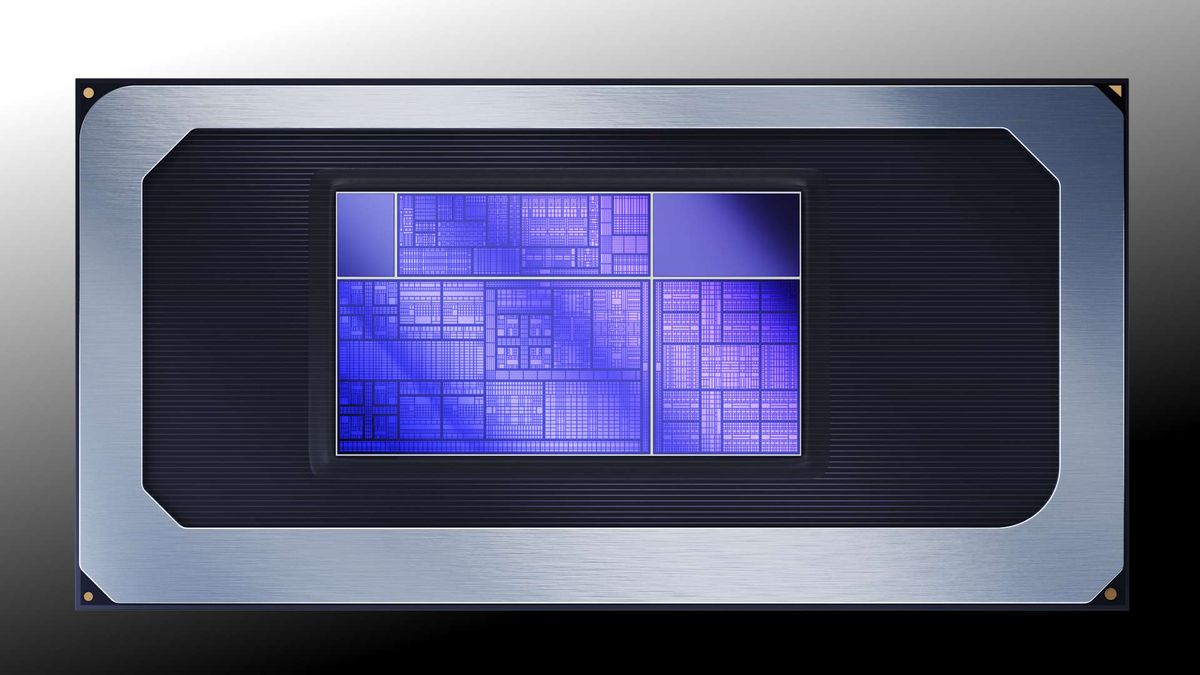
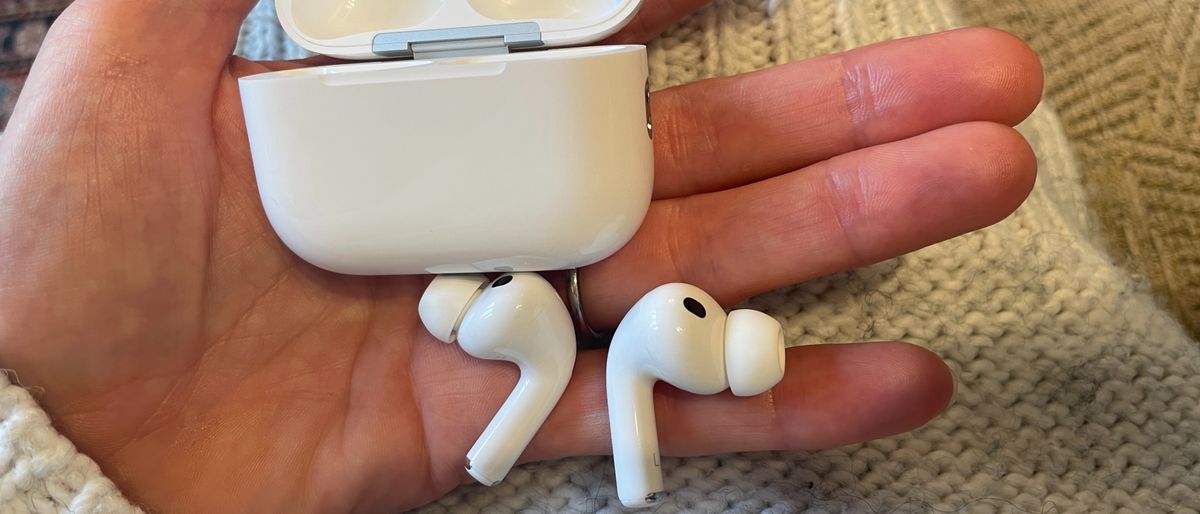
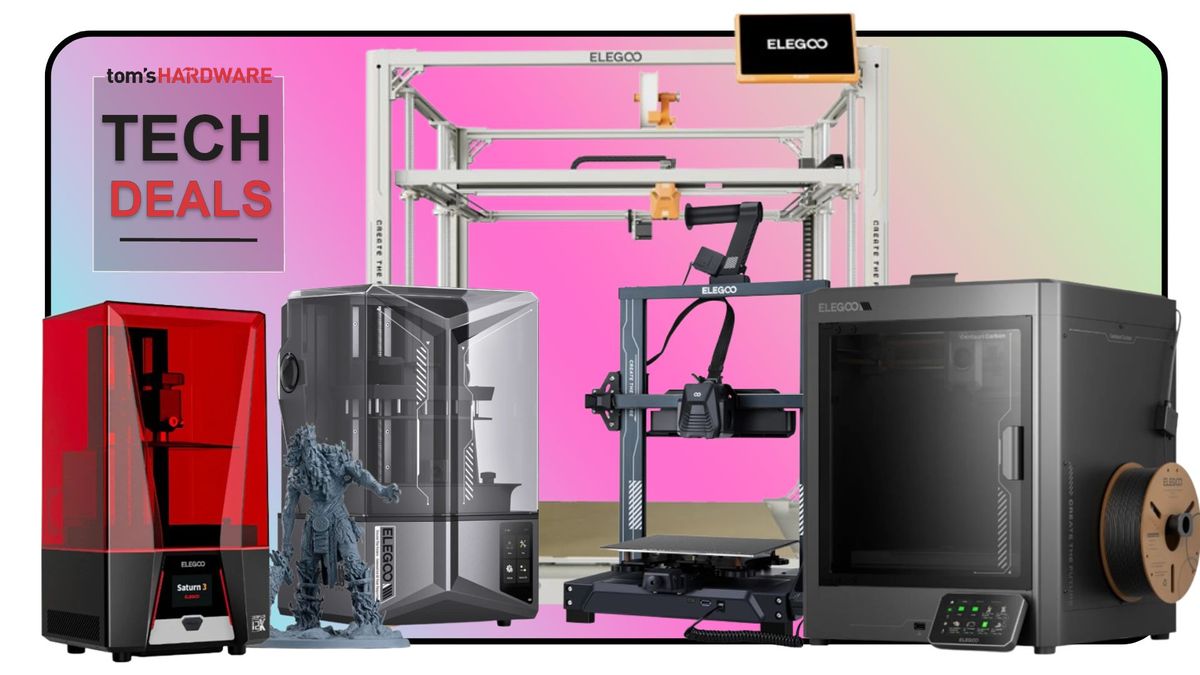
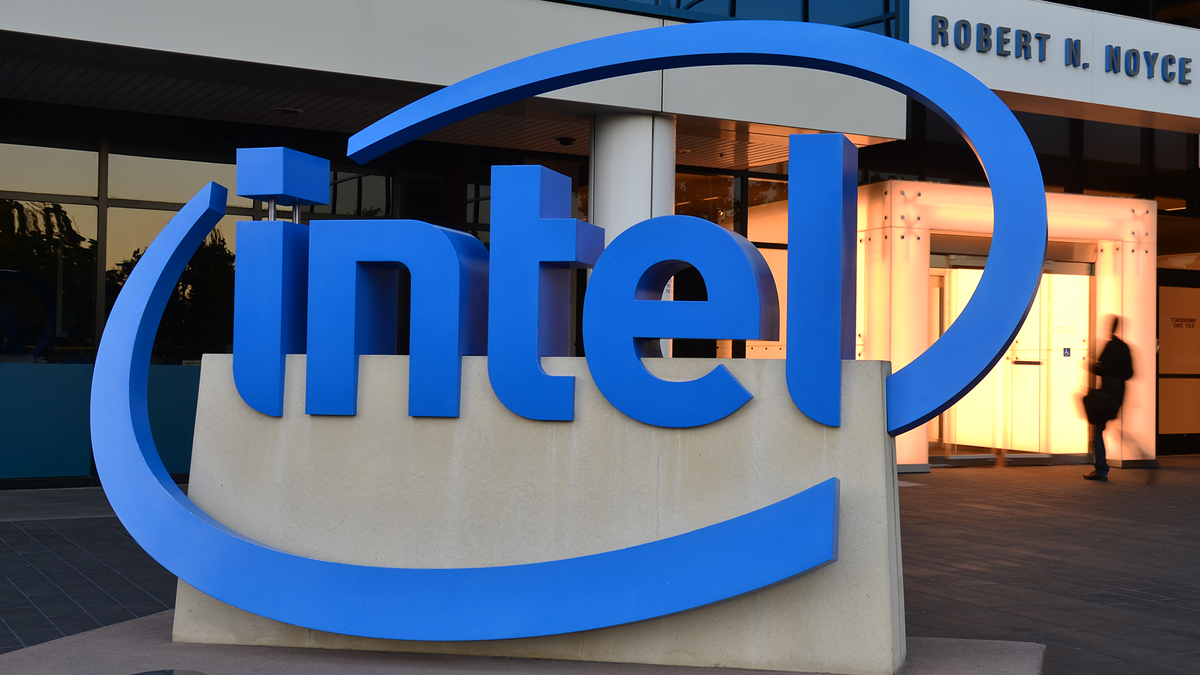





 English (US) ·
English (US) ·